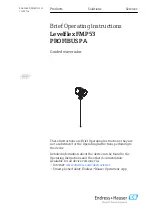
2-2
2.2 False Echoes
Occasionally echo signals appear on the
screen at positions where there is no target
or disappear even if there are targets. They
are, however, recognized if you understand
the reason why they are displayed. Typical
false echoes are shown below.
Multiple echoes
Multiple echoes occur when a transmitted
pulse returns from a solid object like a large
ship, bridge, or breakwater. A second, a third
or more echoes may be observed on the dis-
play at double, triple or other multiples of the
actual range of the target as shown below.
Multiple reflection echoes can be reduced
and often removed by decreasing the gain
(sensitivity) or properly adjusting the A/C SEA
control.
Own ship
Target
True
echo
Multiple
echo
Figure 2-2 Multiple echoes
Sidelobe echoes
Every time the radar pulse is transmitted,
some radiation escapes on each side of the
beam, called “sidelobes.” If a target exists
where it can be detected by the side lobes
as well as the main lobe, the side echoes
may be represented on both sides of the true
echo at the same range. Side lobes show
usually only on short ranges and from strong
targets. They can be reduced through care-
ful reduction of the gain or proper adjustment
of the A/C SEA control.
Range resolution
Range resolution is the ability to display as
separate pips the echoes received from two
targets which are on the same bearing and
close to each other. This is determined by
pulselength only. Practically, a 0.08 microsec-
ond pulse offers the discrimination better than
35 m as do so with all FURUNO radars.
Test targets for determining the range and
bearing resolution are radar reflectors hav-
ing an echoing area of 10 m
2
.
Bearing accuracy
One of the most important features of the ra-
dar is how accurately the bearing of a target
can be measured. The accuracy of bearing
measurement basically depends on the nar-
rowness of the radar beam. However, the
bearing is usually taken relative to the ship’s
heading, and thus, proper adjustment of the
heading line at installation is an important fac-
tor in ensuring bearing accuracy. To minimize
error when measuring the bearing of a tar-
get, put the target echo at the extreme posi-
tion on the screen by selecting a suitable
range.
Range measurement
Measurement of the range to a target is also
a very important function of the radar. Gen-
erally, there are two means of measuring
range: the fixed range rings and the variable
range marker (VRM). The fixed range rings
appear on the screen with a predetermined
interval and provide a rough estimate of the
range to a target. The variable range marker’s
diameter is increased or decreased so that
the marker touches the inner edge of the tar-
get, allowing the operator to obtain more ac-
curate range measurements.
Summary of Contents for FR-1710
Page 1: ...MARINE RADAR MODEL FR 1710 1725 1760DS...
Page 78: ......
















































